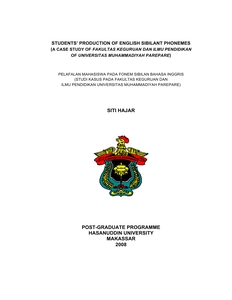HAJAR, SITI (2008) STUDENTS’ PRODUCTION OF ENGLISH SIBILANT PHONEMES (A CASE STUDY OF FAKULTAS KEGURUAN DAN ILMU PENDIDIKAN OF UNIVERSITAS MUHAMMADIYAH PAREPARE). Thesis thesis, Universitas Hasanuddin.
![[thumbnail of Cover]](/7442/1.hassmallThumbnailVersion/sitihajar-400-1-ps0409%20cover.jpg)

sitihajar-400-1-ps0409 cover.jpg
Download (268kB) | Preview
sitihajar-400-1-ps0409 1-2.pdf
Download (517kB)
sitihajar-400-1-ps0409 dapus-lam.pdf
Download (341kB)
sitihajar-400-1-ps0409.pdf
Restricted to Repository staff only
Download (1MB)
Abstract (Abstrak)
ABSTRACT
This research scrutinizes the students’ abilities to produce the sibilant sounds correctly and to describe how their teacher’s technique that help them.
This research was carried out at Fakultas Keguruan dan Ilmu pendidikan of Universitas Muhammadiyah Parepare (FKIP UMPAR). The method used was descriptive method by observing the students’ abilities to pronounce the sibilant sounds and the teachers’ techniques to help them in pronouncing the sibilants. The sample was selected using cluster random sampling. The data were analyzed into percentage to find the average of the presence of the target sounds; the result of questionnaire is tabulated and analyzed.
Based on the result of observation, it is concluded that : 1)The result of students’ production of sibilant phonemes shows: the /s/ sound is easy to pronounce by the respondents; the /z/, /∫/ and /ʒ/ phonemes are difficult to pronounce by the respondents; from the three tasks, the accurateness of respondents’ pronunciation tends to decline. It seems that they are able to produce the target sound in word list, then the accurateness reduces in sentence and paragraph; in the matter of pronouncing the alveolar sibilant (/s/ and /z/; the respondents tend to interchange the phonemes into palato-alveolar sibilants (∫/ and /ʒ/, or voiced sibilants into voiceless one; a part of the respondents can apply their knowledge background in order to achieve the accurateness of the pronunciation, 2) The teachers’ techniques used to help the students produce the sibilant sounds: teach the unfamiliar sound symbols, show the students how to pronounce them, asked the students practice the sibilant sounds communicatively, take the learner-centered approach, look up some words in dictionary and pronounce them in pair works, show the picture of a speech organ ; It did not seem that the techniques applied by the teachers had maximally helped the students to pronounce /z/, /∫/ and /ʒ/. It may caused by the interference of the students’ mother tongue and their limited knowledge of how to articulate the target sounds correctly.
| Item Type: | Thesis (Thesis) |
|---|---|
| Subjects: | P Language and Literature > PE English P Language and Literature > PR English literature |
| Depositing User: | Kamaluddin |
| Date Deposited: | 07 Oct 2021 04:22 |
| Last Modified: | 07 Oct 2021 04:22 |
| URI: | http://repository.unhas.ac.id:443/id/eprint/7442 |


